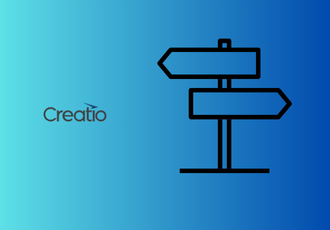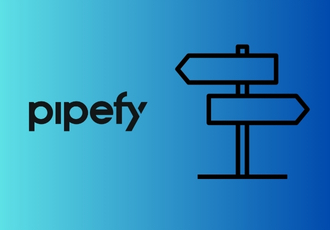Creatio is a no-code, AI-enabled development platform that offers tools for workflow automation, customer relationship management (CRM), and low-code application development. It is designed to support a wide range of business processes and is used by organizations across various industries.
That said, as operational demands increase, some teams may find that the platform's structure and requirements don’t fully align with their needs.
In this guide, we will look at Creatio alternatives, their features, pros and cons, and why FlowForma emerges as a top Creatio competitor.
Creatio Limitations
As organizations scale, several practical considerations may affect the long-term suitability of Creatio. These include:
- Rising costs escalate with advanced automation and integrations
- Frequent, disruptive updates
- High incident response times can pose challenges, especially during time-sensitive incidents.
- Steep learning curve, particularly when configuring complex workflows or features
- Complex automation often requires external tools
Creatio Pricing
Creatio offers a modular, subscription-based pricing model. The pricing varies depending on the number and type of users, products chosen, deployment method, and any required add-ons like AI tools or custom integrations.
 Creatio’s tiered pricing plans
Creatio’s tiered pricing plans
Creatio’s product pricing is set at $15/user/month, while AI tokens are priced at $150 per pack. Creatio also offers additional user-type pricing plans at $12/user/month.
It is also important to note that the minimum purchase is priced at $10,000 per year for new customers.
The Top 10 Creatio Alternatives You Must Consider
Here’s a curated list of the top ten tools you can consider as substitutes for Creatio:
Best Creatio Competitors in 2025 |
|||||
|
Tool |
FlowForma |
Make |
Appian |
Kissflow |
Microsoft Power Apps |
|
Type |
100% No-code |
No-code |
Low-code |
Low-code/No-code |
Low-code |
AI Capabilities |
Copilot + AI Agent + AI Summarization |
AI Agents |
AI Copilot |
AI-assisted app creation |
Copilot + AI agent authoring + AI summarization |
Ease of Use |
Business-user friendly |
Geared for professional users |
Requires technical expertise |
Minimal IT involvement |
Easy for Microsoft 365 users |
|
Speed of Deployment |
1-2 weeks |
Varies based on complexity |
Several weeks to months |
Quick deployment |
Varies based on complexity |
Integrations |
Deep MS 365, SharePoint, or Teams Integration, 1,000+ systems |
2000+ apps, including HTTP/REST API support |
Salesforce, Google, SharePoint, DocuSign, AWS |
Integrates with Google Workspace |
100+ external connectors, including Microsoft and third-party apps |
Pricing |
Tiered, process-based |
Usage-based |
Custom |
Tiered |
Tiered |
Let’s break down the top Creatio alternatives you can choose for your unique business needs in 2025:
1. FlowForma
 FlowForma’s homepage
FlowForma’s homepage
FlowForma is a cloud-based, AI-powered business process automation platform built for end-to-end workflow management. Its intuitive interface and drag-and-drop functionality empower users to independently create, optimize, and manage workflows quickly, eliminating major reliance on IT or coding expertise.
FlowForma’s Key Features
FlowForma’s AI-driven workflow creation, robust compliance features, and user-friendly interface make it a better choice over Creatio for businesses looking to streamline operations and enhance productivity. Key features include:
- AI capabilities: FlowForma’s AI innovations, like Copilot, Agent, and Summarization, further accelerate and simplify automation processes using LLM-powered Process Agent. Users can modify and manage workflows using natural language prompts, diagrams, or forms instead of manually defining steps, questions, or logic paths.
Want to see FlowForma's AI capabilities in action? Watch Copilot build an insurance policy renewal process in seconds in this interactive demo.
- Drag-and-drop workflow builder: Design any workflow, from simple approvals and claims handling to multi-stage compliance approvals and onboarding with FlowForma’s intuitive visual designer. Users can also configure complex rules like delegation, escalations, audit snapshots, etc., through point-and-click settings, for consistency and auditability.
 FlowForma’s workflow builder seamlessly builds custom workflows
FlowForma’s workflow builder seamlessly builds custom workflows
- Governance and compliance: FlowForma offers a comprehensive set of governance and compliance features, including built-in audit trails for process transparency, role-based access controls to safeguard data, and a dedicated compliance module. This module is designed to support alignment with key regulatory standards such as the Digital Operational Resilience Act (DORA), GDPR, and ISO 27701. It also allows organizations to manage risk and maintain compliance across automated workflows.
- Automated document generation: FlowForma’s automated document generation feature enables users to create documents—such as contracts, reports, and proposals—directly within workflows, without the need for third-party tools. Using a no-code template builder via the FlowForma Word add-in, users can dynamically populate documents with data from forms, tables, images, and even e-signatures. Documents can then be automatically converted to PDF and distributed securely, supporting compliance and efficiency.
FlowForma’s Pros
- Fast automated approval process with a unified view and centralized storage
- Seamless integration with existing or legacy systems
- Real-time reporting features for accurate, data-driven insights
- 10x faster deployment with users becoming self-sufficient in just weeks
FlowForma’s Cons
- Need to be using SharePoint Online and/or Office 365 for best results
- Does not cater to small-scale organizations
FlowForma’s Pricing
FlowForma has a simple, tiered pricing structure. With no hidden costs, pricing starts at £2067 per month for automating up to three processes.
 FlowForma’s tiered pricing modules
FlowForma’s tiered pricing modules
Explore FlowForma’s automation capabilities risk-free with a 7-day free trial.
2. Make

Make’s no-code development platform
Make.com is a no-code automation platform that allows users to build and automate workflows by connecting apps and services through a visual interface. The platform is used for tasks such as data syncing, notification management, and custom process automation across business functions. Its free tier and low-cost plans make it attractive for small businesses with limited budgets. However, it is not designed for mid-size businesses or enterprises as it struggles with complex workflows.
Make’s Key Features
- Drag-and-drop interface connects apps in a few clicks
- Bird’s-eye, unified view of the automation landscape with Make Grid
- 2000+ pre-built integrations with AI apps
- Real-time workflow builder with Scenarios
Make’s Pros
- Easy and intuitive platform
- Clear pricing subscription
- Quick implementation
Make’s Cons
Make’s Pricing
Make offers the following pricing models:
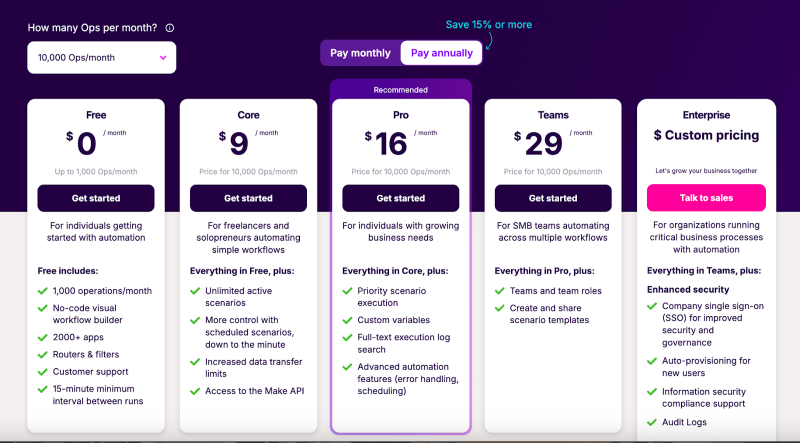
Make’s pricing plans
3. Appian
Appian is a low-code application platform offering end-to-end process automation with RPA, AI, IDP, and API integrations. It helps businesses streamline workflows, automate tasks, and develop custom applications quickly with minimal coding.

Appian’s low-code development platform
Appian’s Key Features
- Native continuous integration/continuous deployment (CI/CD) and governance for low-code development at scale
- Gen AI to create custom AI models
- End-to-end process automation with RPA, AI, IDP, and API integrations
Appian’s Pros
Appian’s Cons
Appian’s Pricing
Appian provides three plans, based on a set of conditions, the actual cost of which is not disclosed publicly.
|
Offering |
Standard |
Advanced |
Premium |
|
Low-Code Process and Application Development |
✔️ |
✔️ |
✔️ |
|
Mobile Apps |
✔️ |
✔️ |
✔️ |
|
Integrations |
✔️ |
✔️ |
✔️ |
|
Portals ², ³ Unlimited Unauthenticated Use |
✔️ One Portal per app |
✔️Unlimited Portals |
✔️Unlimited Portals |
|
Case Management Studio |
✔️ |
✔️ |
|
|
Offline Mobile |
✔️ |
✔️ |
|
|
Autoscale ⁶ |
✔️ |
✔️ |
|
|
AI Copilot for Developers ², ⁵ |
✔️Token limit applies |
✔️Token limit applies |
✔️Token limit applies |
|
AI Copilot for Business Users ⁵ |
✔️Token limit applies |
✔️Token limit applies |
|
|
AI Skills with Generative AI ⁵ |
✔️Token limit applies |
✔️Token limit applies |
|
|
AI Skills with Email and Document Classification ² |
✔️ |
✔️ |
|
|
AI Skills with Intelligent Document Extraction ², ³ |
✔️20,000 pages per month |
✔️50,000 pages per month²²² |
|
|
Conditions: 1 For cloud customers, this is the Appian Cloud Database. ² This feature may not be available or may have limited functionality in on-premises or self-managed scenarios. ³ This represents the entitlement per application for Standard User, Advanced User, and Premium User. For Platform - Standard User, Platform - Advanced User, and Platform - Premium User, this represents the total entitlement across all applications. ⁴ Starting with the 24.2 release, RPA is available for self-managed customers using Appian on Kubernetes. ⁵ The token limit for AI at the Standard tier is 100M tokens per month. The token limit for AI at the Advanced tier is 200M tokens per month. The token limit for AI at the Premium tier is 500M tokens per month. ⁶ Requires additional licensing |
|||
Related read: Check out this article exploring the top 10 Appian alternatives for business automation.
4. Kissflow
Kissflow offers both low-code and no-code capabilities, offering a dual-development approach. Users can opt for a low-code approach for complex processes or simply use the intuitive drag-and-drop interfaces for simple workflows.
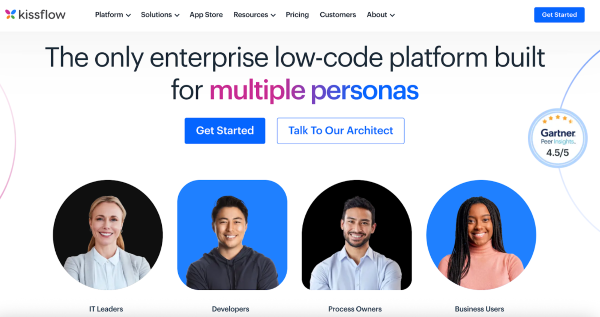 Kissflow’s low-code development platform
Kissflow’s low-code development platform
Kissflow’s Key Features
- Supports both simple workflows and complex case management
- Built-in collaboration features
- AI-powered low-code app development
- Fast delivery to reduce app backlog
Kissflow’s Pros
- Citizen developer-friendly low-code platform
- Easy visuals with controlled changes and updates
- Processes and datasets contained in a single environment
Kissflow’s Cons
- Lack of privacy-focused features
- External integration requires customer support
Related Read: Check out this comprehensive guide on Kissflow alternatives
Kissflow’s Pricing
Kissflow offers a flexible pricing plan:
 Kissflow’s flexible pricing plan
Kissflow’s flexible pricing plan
5. Microsoft Power Apps
Power Apps is a low-code platform within Microsoft’s Power Platform, enabling users to build custom business applications. Its drag-and-drop interface allows citizen developers to create apps tailored to their specific operational needs.
 Microsoft Power Platform
Microsoft Power Platform
Power App’s Key Features
- Minimal-code, professional app development
- Enterprise compliance and governance
- AI builder with mobile-first design
Power App’s Pros
- Drag-and-drop intuitive interface
- Seamless connection with the Microsoft 365 cloud environment
Power App’s Cons
- Lacks an efficient debugger
- Complex licensing structure
Related read: Check out the best Power Apps alternatives here.
Power App’s Pricing
Power Apps offers the following pricing plans:

Power Apps pricing plans
6. ProcessMaker
ProcessMaker’s low-code functionality allows organizations to automate mission-critical processes within seconds. Users can design, optimize, and automate workflows quickly in a unified environment.
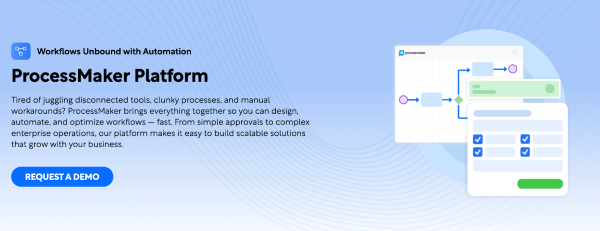
ProcessMaker’s process automation platform
ProcessMaker’s Key Features
- Drag-and-drop forms and approval flows
- AI-driven document creation
- Multiple AI agent applications
- Conditional, logic-based workflow design
ProcessMaker’s Pros
- Quality customer support
- Easy system integration
ProcessMaker’s Cons
- Creating a process requires extensive training
- Time-consuming setup process
ProcessMaker Pricing
ProcessMaker has three pricing plans, but the pricings are not disclosed publicly.
 ProcessMaker’s pricing plans
ProcessMaker’s pricing plans
7. WorkflowGen
WorkflowGen is a no-code process automation platform. It combines business process management with AI capabilities to support the automation of internal business processes.

WorkflowGen’s homepage
WorkflowGen’s Key Features
- Controlled and transparent automation of complex processes
- Compliant, AI-augmented processes
- Harmonious and sequential AI agent orchestration
- Tailored workflows for specific process needs
WorkflowGen’s Pros
- Easy to use, develop, and deploy
- Consistent and effective customer support
WorkflowGen’s Cons
- Slow drag-and-drop feature
- Frequent revisions and version releases
WorkflowGen’s Pricing
WorkflowGen’s pricing plans are not disclosed publicly.
 WorkflowGen’s pricing page
WorkflowGen’s pricing page
8. Nintex
Nintex’s AI-powered, low-code development platform allows users to quickly launch purpose-built applications with automation intelligence and agentic workflows.
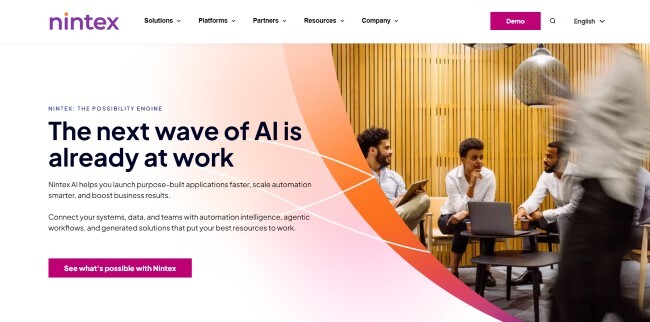 Nintex process automation platform
Nintex process automation platform
Nintex’s Key Features
- Drag-and-drop UI with real-time analytics
- AI-powered workflow automation
- Pre-approved templates for compliance
- Full visibility and process control
Nintex’s Pros
- Comprehensive roadmap for successful process automation
- Easy-to-use workflow features
- Integrates with existing system
Nintex’s Cons
- Complex customizations require technical skills
- Steep learning curve
Nintex’s Pricing
Nintex pricing plans are not disclosed publicly but you can check out this guide to get an in-depth understanding of Nintex’s pricing and alternatives.
9. Pipefy
Pipefy is an AI-powered, no-code development platform. It standardizes, streamlines, and connects workflows for better end-user experiences and faster business results.
 Pipefy’s no-code AI development platform
Pipefy’s no-code AI development platform
Pipefy’s Key Features
- No-code workflow builder
- Autonomous AI agents
- Context-aware AI-guided flows
- Visual low-code for scalable workflows
Pipefy’s Pros
- Easy-to-use platform
- User-friendly interface with updated maintenance
- Customization, integration, and automation variety
Pipefy’s Cons
- Lacks a general dashboard
- Complex and cumbersome registration process
Pipefy’s Pricing
Pipefy offers four pricing modules, including a free starter plan. However, the costs of the other three are not disclosed publicly.
 Pipefy’s pricing plans
Pipefy’s pricing plans
10. Pega
Pega is a low-code, enterprise-grade process automation platform. Users can create applications, manage workflows, and automate business processes with minimal coding expertise.

Pega’s enterprise-grade low-code development platform
Pega’s Key Features
- Intuitive low-code interface
- Built-in AI for automation and recommendations
- Dynamic case management
- Integration with CRM, ERP, and cloud systems
Pega’s Pros
- Easy to monitor the RPA execution
- Interactive visual builder and drag and drop feature
Pega’s Cons
- Difficulty changing code when issues persist
- Steep learning curve for implementation of complex requirements
Pega’s Pricing
Pega’s pricing plans are not disclosed publicly.
Why FlowForma Is The Best Creatio Alternative For Your Business
.png?width=1000&height=225&name=G2%20Home%20Page%20Logos%20(2).png) FlowForma customer testimonials
FlowForma customer testimonials
While Creatio has certain advantages, scaling beyond CRM use cases demands developer support or paid services. FlowForma, by contrast, is purpose-built for digital business process automation.
Here are the key reasons why FlowForma stands out as the best Creatio alternative:
1. Rapid ROI for empowered users
FlowForma’s 100% no-code platform enables users to independently and quickly automate approvals, audits, and workflows—saving time and boosting efficiency. In fact, customers report ROI in under 6 weeks, over 6,000 hours saved across five processes, and 75% fewer emails.
 FlowForma facilitates rapid ROI with 10x faster deployment
FlowForma facilitates rapid ROI with 10x faster deployment
2. Agentic AI
FlowForma’s Agentic AI is a prompt-driven AI agent that fits directly into any step of a workflow. It delivers real-time, context-aware answers based on your custom instructions—no coding or complex setup required. By automating decisions, repetitive questions, and step-specific logic, it removes delays and manual handoffs. Unlike heavier AI platforms, it’s modular, fast to deploy, and empowers business users to get instant value, making automation smarter and more efficient without IT overhead.
In a recent webinar, we shared how a leading financial services client leveraged our AI capabilities to accelerate prototyping, streamline process development, and boost productivity. Explore the full case study here:
4. Cross-functional collaboration
FlowForma breaks silos reducing rework, misalignment and downstream compliance risks with collaborative work management(CWM) in a secure and collaborative way.
4. Seamless integration with existing and legacy systems
FlowForma runs on SharePoint and integrates with Microsoft 365, enabling collaboration, reporting, and adoption without disrupting existing systems.

Bid adieu to operational bottlenecks and cost overruns. Switch to FlowForma today. Sign up for a live demo!
 By
By 